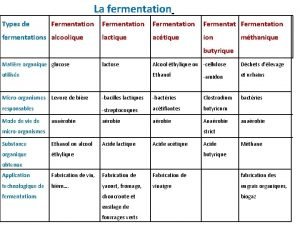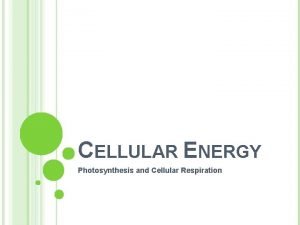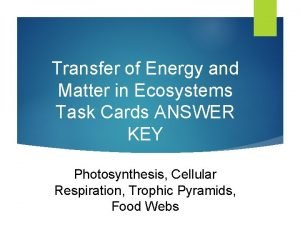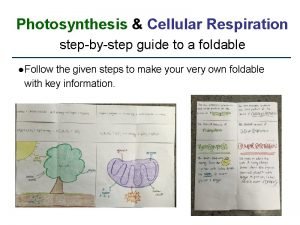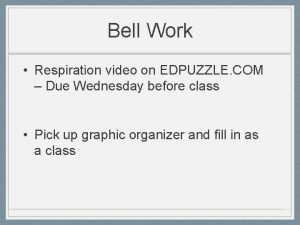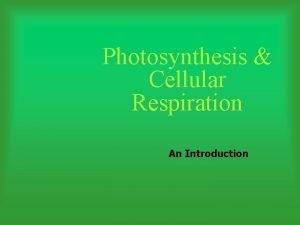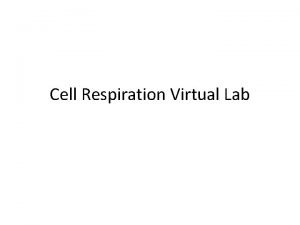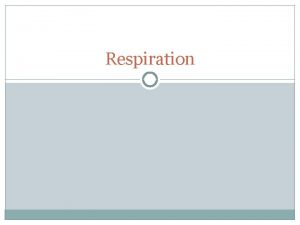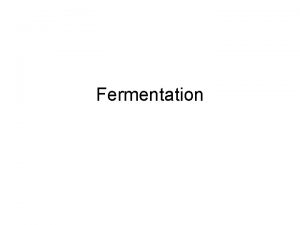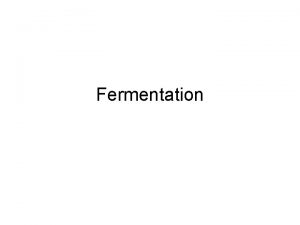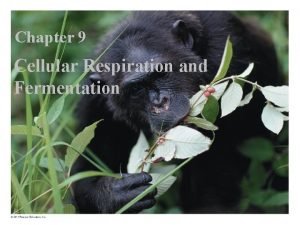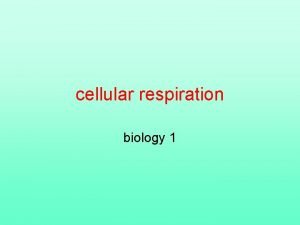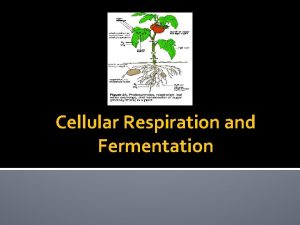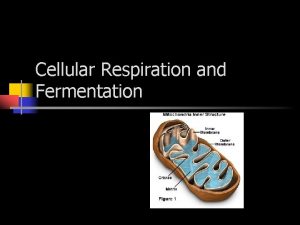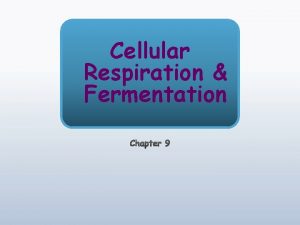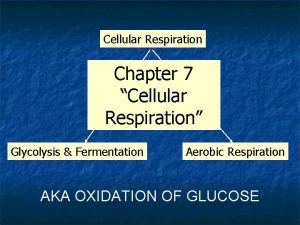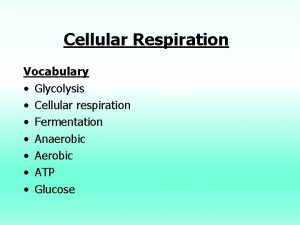Lec 6 Fermentation and Cellular Respiration Fermentation the



















- Slides: 19

Lec 6

�Fermentation and Cellular Respiration ◦ Fermentation �the degradation of a sugar that occurs without the help of oxygen �What type of Metabolic pathway is fermentation is it Catabolic or is it Anabolic? ◦ Catabolic

�Two types of Fermentation ◦ Alcohol fermentation ◦ Lactic acid fermentation Fermentation

�Pyruvate converted to ethanol ◦ 2 Steps � 1 st step releases CO 2 from pyruvate � 2 nd step acetaldehyde reduced by NADH to ethanol Alcohol Fermentation

LE 9 -17 a 2 ADP + 2 P i Glucose 2 ATP Glycolysis 2 Pyruvate 2 NAD+ 2 Ethanol Alcohol fermentation 2 NADH + 2 H+ 2 CO 2 2 Acetaldehyde

�Pyruvate is reduced directly by NADH, ◦ Forms lactate as an end product ◦ no release of CO 2 �Lactic acid fermentation ◦ fungi and bacteria to make cheese and yogurt �Human muscle cells use lactic acid fermentation ◦ to generate ATP when O 2 is scarce Lactic acid Fermentation

LE 9 -17 b 2 ADP + 2 P i Glucose 2 ATP Glycolysis 2 NAD+ 2 NADH + 2 H+ 2 Lactate Lactic acid fermentation 2 Pyruvate

�The ATP made during fermentation is generated by what? ◦ Substrate-level phosphorylation �What is substrate-level phosphorylation? - Production of ATP from ADP by direct transfer of a high-energy phosphate group from a phosphorylated intermediate Fermentation

�What type of Metabolic pathway is substratelevel phosphorylation? (Catabolic or Anabolic) ◦ Catabolic pathway (Release energy) �What type of reaction is substrate-level phosphorylation? (exergonic or endergonic? ) ◦ Exergoinic (energy outward) �So ∆G would ◦ negative be? Fermentation

�Cellular Respiration ◦ Oxygen is consumed as a reactant along with the organic fuel �What type of Metabolic pathway is Cellular Respiration? �In Eukaryotic cells what is the main area/compartment of cellular respiration? �What is the “Fuel” for cellular respiration?

�Oxidation-reduction reactions ◦ A transfer of one or more electrons from one reactant to another �Oxidation ◦ the loss of electrons from one substance �Reduction ◦ the addition of electrons to another substance Redox Reactions

Where does the Oxidation and Reduction Occur? Redox Reactions

Na – is oxidized the loss of electrons Cl – is reduced the gain of electrons Redox Reactions What is the Reducing Agent and what does it reduce? What is the Oxidizing agent and what does it oxidize?

What is the Reducing Agent and what does it reduce? Na – is the Reducing agent (electron donor) Cl – is Reduced What is the Oxidizing agent and what does it oxidize? Cl – is the Oxidizing agent (electron acceptor) Na – is Oxidized Redox Reactions

Where does the Oxidation and Reduction Occur? Redox Reactions

Redox Reactions

Cellular Respiration � During cellular respiration, the fuel (such as glucose) is oxidized and oxygen is reduced: becomes oxidized C 6 H 12 O 6 + 6 O 2 6 CO 2 + 6 H 2 O + Energy becomes reduced Some redox reactions do not transfer electrons but change the electron sharing in covalent bonds This is what occurs here the IMPORTANT point is that the change in the covalent status of electrons as hydrogen is transferred to oxygen is what liberates energy

�Is a series of steps ◦ Cellular respiration DOES NOT oxidize glucose in a single step that would transfer all the hydrogen from the fuel to the oxygen at one time. ◦ Fuel, glucose is broken down in steps ◦ Each step is catalyzed by an enzyme. �Hydrogens are stripped from glucose then usually passed first to the coenzyme NAD+ ◦ NAD+ functions as an Oxidizing agent ◦ NAD+ + H NADH Cellular Respiration

�Krebs Cycle ◦ http: //www. youtube. com/watch? v=Wc. Rm 3 MB 3 OKw �Glycolysis ◦ http: //www. youtube. com/watch? v=n. Kg. UBs. C 4 Oyo ◦ http: //www. youtube. com/watch? v=ub 1 z. Tk. ZL 5 s. E �Making Cycle ATP (make it rain remix) Kreb ◦ http: //www. youtube. com/watch? v=Yy. N 0 wx 2 AHf. E&f eature=related Videos
 La respiration et la fermentation
La respiration et la fermentation The process of photosynthesis and cellular respiration
The process of photosynthesis and cellular respiration Photosythesis equation
Photosythesis equation What is the equation for cellular respiration in words
What is the equation for cellular respiration in words Function of cellular respiration
Function of cellular respiration Where does cellular respiration take place
Where does cellular respiration take place Photosynthesis and cellular respiration foldable
Photosynthesis and cellular respiration foldable Edpuzzle
Edpuzzle Photosynthesis and cellular respiration
Photosynthesis and cellular respiration Cellular respiration virtual lab snails and elodea
Cellular respiration virtual lab snails and elodea Flocabulary photosynthesis read and respond answers
Flocabulary photosynthesis read and respond answers Photosynthesis and cellular respiration jeopardy
Photosynthesis and cellular respiration jeopardy Cellular respiration redox
Cellular respiration redox The gray-brown haze often found over large cities is called
The gray-brown haze often found over large cities is called Cellular respiration steps
Cellular respiration steps Aerobic vs anaerobic
Aerobic vs anaerobic Fermentieren bedeutung
Fermentieren bedeutung Why is cellular respiration important
Why is cellular respiration important Summary equation for cellular respiration
Summary equation for cellular respiration Cellular respiration reactants
Cellular respiration reactants
